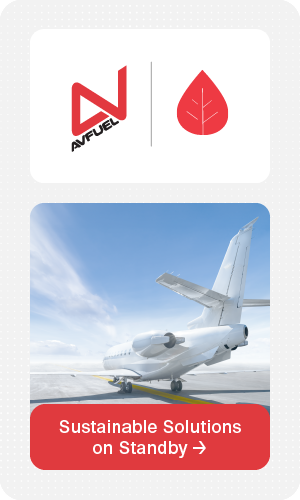In late fall of 2018 I received a call about an event being planned by a coalition of international business aviation associations in cooperation with local civic leaders at Van Nuys Airport in Los Angeles. The event would showcase the viability of sustainable aviation fuel (SAF)—proven to be a safe and viable drop-in Jet-A fuel that reduces net green-house emissions by up to 80 percent. This was my first experience with the practical steps our industry was taking toward operating more sustainably, and it launched my own interest in helping Clay Lacy Aviation implement a comprehensive sustainability strategy.
What is Sustainability? (And Why Should You Care?)
Before I go further, let me cut through all the hype—both positive and negative—and explain that sustainably simply refers to the concept of replacing a linear consumption mode with a circular one. Jet-A is currently processed from petroleum, which is a limited resource. Once it is refined and burned, it can’t be used again. SAF, by comparison, starts with a waste product that would otherwise go to a landfill, such as municipal solid waste, and refines it into jet fuel.
Now, why should aviation businesses care about operating sustainably? Here at Clay Lacy Aviation, three simple reasons convinced us to establish a corporate sustainability program.
- To prepare us to comply with future regulations (Trust me, they are coming.)
- To strengthen our competitive advantage and leadership position
- To do the right thing for current and future generations
How Clay Lacy Got Started Toward a More Sustainable Future
If you are reading this article in NATA’s Aviation Business Journal, you are more than likely an aviation professional. You are an expert in your chosen field, whether it be flight operations, maintenance, safety, ground handling, and so on. But you are probably not an expert in sustainability.
The first step is to acknowledge the complexity of sustainability and to seek professional advice from a sustainability expert. We reached out to World Kinect Energy Services, a subsidiary of World Fuel Services. World Kinect hosted a multi-month workshop for our leadership team, helping us understand the background, history, definitions, and scope of sustainability. They walked us through case studies, stakeholder engagement, and entry points for making sustainability commitments.
Upon completion of the workshop, the World Kinect experts walked us through building Clay Lacy Aviation’s corporate sustainability strategy, complete with goals, milestones, and strategies to achieve our sustainability commitments. With the help of a sustainability expert,
we were able to develop and implement a program that we knew was in line with our corporate values and business strategy. The entire process took about a year to complete.
Clay Lacy Aviation’s Sustainability Strategy
Our strategy is holistic with measurable, interrelated goals, all designed to create or enhance value. These goals fall into one of three categories:
- Environment: protecting the health and purity of air, land, and water
- People: promoting the well-being of our employees, customers, and community
- Longevity: ensuring our continued growth and success as an organization
Since introducing our sustainability strategy in January 2021, Clay Lacy Aviation has made great strides toward our goals. We introduced a carbon offset program for our aircraft management and FBO customers, installed 30,000 square feet of solar panels and 40 EV
charging stations, began transitioning to LED lighting fixtures, and started offering SAF at our FBOs. We also started phasing out plastic water bottles and single-use plastics from our facilities, developed an environmental purchasing policy, and more.
As I write this article, we are undergoing the first independent sustainability audit of our carbon footprint calculations and carbon offset programs conducted by 4AIR, another of our expert sustainability partners. And, before the year is out, we will establish an environmental committee focused on educating our employees and developing new strategies to further reduce our environmental impact.
Four Basic Steps to Becoming More Sustainable
There is a proven, four-step methodology to transition your organization toward sustainability.
1. Measure: Accurately gauge and report your current consumption levels, commonly referred to as measuring your carbon footprint. How much electricity, natural gas, heating oil and so forth does your organization use annually?
2. Reduce: Once you have a baseline, find ways to reduce your consumption—from replacing old lighting fixtures with LEDs to installing low-flow water faucets.
3. Replace: Explore alternate products to replace the things you are consuming with more sustainable options. Stop buying plastic bottled water for the office and install a water filter system. Begin purchasing SAF and transition to electric or renewable diesel-powered ground service equipment. Install a solar system to generate electricity or, if offered through your power utility, purchase electricity from renewable resources at a slight premium.
4. Offset: You won’t be able to eliminate everything, so offset what you cannot eliminate. Carbon offsets allow you to fund projects that are reducing carbon emissions around the globe. Carbon offsets are not a permanent solution, but an immediate action you can take to counterbalance those emissions that can’t be eliminated.
Additional Resources to Get Started
For corporate flight departments, it is very likely that your company already has a corporate sustainability strategy. Seek out the leader of that program and learn about your company’s sustainability goals. Understanding those goals will help you focus your research on what your division or department can do to help to your business achieve them.
NATA and other international aviation organizations are actively developing new guidance and best practices to help aviation businesses of all sizes get started on their sustainability journeys. In 2020 NATA formed its Environmental Committee, a cross-functional team of aviation experts that assists in the association’s sustainability policy and priorities and offers NATA members practical guidance for making efficiency gains to reduce their environmental impact.
Auditing Sustainability Claims
Due to the complexity of environmental issues, a key element of Clay Lacy Aviation’s sustainability strategy was to independently verify that we actually accomplish what we set out to achieve. For that we selected 4AIR to perform annual audits of carbon footprint calculations for all our facilities and aircraft operations. The audit also assures that the carbon offsets we purchase are properly retired and recorded.
Our Journey Continues
As is true for so many important things in life and business, sustainability is a process rather than an event. Over time there will be new and more cost-efficient ways to consume less non-renewable energy, generate fewer harmful emissions, and operate more sustainably. Although our strategy will evolve as we achieve the goals we have already set for ourselves and pursue new goals in the years to come, we will continue to educate and motivate our employees, serve as a resource of ideas and programs for our clients, and share our insights and experience with other companies as they begin sustainability journeys of their own.






